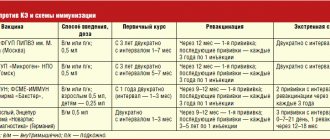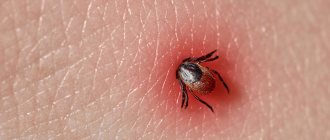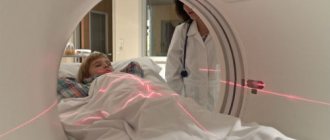Tick-borne encephalitis (Spring-summer tick-borne meningoencephalitis, Tick-borne viral encephalitis)
The latent or incubation period of the disease lasts approximately 1-2 weeks. But both fulminant forms, when 24 hours pass from the moment of infection to the first signs, and protracted forms of the disease, with an incubation period of up to 1 month, can occur.
During the latent period, viral particles multiply intensively at the site of penetration (skin wound or intestinal wall), then enter the blood and are spread throughout the body. It is this moment that marks the appearance of the first clinical symptoms. The second peak of flavivirus reproduction occurs in internal organs (central nervous system, kidneys, lymph nodes, liver).
All forms of tick-borne encephalitis (febrile, meningeal, focal) have common initial symptoms. The disease begins acutely; in many cases, the patient can clearly indicate even the hour when his condition sharply worsened. The first symptoms are reminiscent of the flu: chills, muscle aches, arthralgia, headache, weakness, lethargy, vomiting and convulsions may be observed against the background of a sharp rise in body temperature (typical for children). Upon examination, attention is drawn to redness of the skin of the face, neck up to the collarbones, and the whites of the eyes with dilated blood vessels. The subsequent course of the disease directly depends on the form in which it will occur in a particular patient.
Feverish form
Tick-borne encephalitis in this form occurs with a predominance of a febrile state, which can last from 2 to 10 days. In most cases, it is of a wave nature, that is, after the first rise in temperature and the subsequent subsidence of clinical manifestations, the disease seems to return again and is followed by a new attack of fever, lasting several days. After about 10 days, the body temperature returns to normal, and the patient’s general condition improves. However, weakness, lack of appetite, palpitations, and sweating can be observed for another 1 month after laboratory recovery (according to the results of blood and cerebrospinal fluid tests).
Meningeal form
This form is characterized by the appearance on days 3-4 of the disease of signs of meningitis - damage to the membranes of the spinal cord and brain. Manifested by the following symptoms: severe headache, which is not relieved by painkillers; vomiting, increased sensitivity of the skin, when even touching clothing to the body causes pain; rigidity (strong tension) of the neck muscles, which leads to involuntary tilting of the head back; Kernig's symptom - the inability to voluntarily straighten a leg at the knee that is bent at right angles at the knee and hip joint in a supine position; upper and lower Brudzinski's symptoms - when the doctor tries to tilt the patient's head forward (chin to chest) and when pressing on the pubis, a reflex flexion of the legs occurs in the knee and hip joints.
All these manifestations of the disease are united by the concept of meningeal syndrome and mean that the tick-borne encephalitis virus has reached the membranes of the spinal cord and brain. Fever and meningeal symptoms last for approximately 2 weeks. After normalization of temperature, patients continue to experience asthenia (weakness, lethargy), poor tolerance of bright light, loud sounds, and depressed mood for a long time (up to 2 months).
Focal form
It is one of the most severe and most unfavorable prognosis forms of tick-borne encephalitis. It is based on the penetration of the pathogen into the substance of the brain and spinal cord. It is characterized by a sharp increase in body temperature to 40°C and above, with lethargy, drowsiness (hypersomnia), vomiting, convulsions, and chills.
Symptoms of damage to the brain substance are observed with the occurrence of hallucinations, disorders of consciousness, delusions, and disturbances in the perception of time and space. When the brain stem, in which the centers responsible for providing vital functions are located, is involved in the process, respiratory and cardiac dysfunction may be observed. When the virus enters the cerebellar tissue, a disturbance in the sense of balance and trembling in the arms and legs develops. When the spinal cord is damaged, flaccid (with decreased muscle tone) paresis and paralysis of the muscles of the neck, shoulders, upper chest and suprascapular region occur. When the virus penetrates the roots of the spinal cord, radiculitis occurs - pain along the nerve, disruption of voluntary movements, the functions of internal organs, the appearance of skin sensitivity disorders in those parts for which the affected root is responsible.
The focal form of tick-borne encephalitis can be of a two-wave nature (two-wave viral meningoencephalitis), when the first attack of the disease is similar to the usual febrile form, and a few days after the body temperature normalizes, symptoms of damage to the substance of the brain and spinal cord suddenly appear.
A special form of tick-borne encephalitis is progressive, which can develop after any other form of the disease. It is characterized by the development of persistent dysfunctions of the brain and spinal cord several months or even years after the acute period of the disease.
Symptoms of encephalitis
As with any other disease, it is important to quickly track encephalitis and begin treatment. Main symptoms of encephalitis:
- headache,
- dizziness,
- fear of light,
- high temperature (38ºC or higher),
- nausea and vomiting,
- joint pain,
- muscle weakness,
- inability to move an arm or leg.
As the disease progresses, changes in mental state (hallucinations, confusion, changes in personality and behavior, delusions), disorientation, and sometimes seizures may occur.
How the disease progresses largely depends on its cause. Encephalitis can be:
- infectious when it occurs due to primary damage to the brain by an infection, for example, a virus,
- post-infectious, when brain inflammation develops as a complication of another infectious process. Very rarely, encephalitis results from post-vaccination complications,
- autoimmune, due to an unexpected immune reaction,
- chronic, when the cause is difficult to identify due to the slow development of the pathological process.
Sources
- Boucher A., Herrmann JL, Morand P., Buzelé R., Crabol Y., Stahl JP, Mailles A. Epidemiology of infectious encephalitis causes in 2021. //Med. Mal. Infect. -2017. -Vol.v47. -No. 3. - p. 221-235.
- Bröker M., Kollaritsch H. After a tick bite in a tick-borne encephalitis virus endemic area: current positions about post-exposure treatment. // Vaccine. -2008. - Vol. 26. - No. 7. - p.v863-868.
- Crijnen YS., de Vries JM., Schreurs MWJ., Titulaer MJ. Clinical symptoms of patients with autoimmune encephalitis: a guide to timely recognition and treatment. //Ned. Tijdschr Geneeskd. -2019. - Vol. 163.
- Non-profit partnership “National Scientific Society of Infectious Diseases”. Clinical recommendations. Tick-borne viral encephalitis in adults. -2014.
- CDC. Vaccines and Immunizations
Some types of encephalitis
Here we have collected brief information about some of the causes of encephalitis.
- Tick-borne encephalitis is caused by an RNA virus from the Arbovirus group, genus Flaviviridae. Its main carriers are ticks from the order Ixodida (ixodid ticks). Taiga encephalitis, in fact, is the so-called “Far Eastern” subtype of tick-borne encephalitis virus, differing from it in the zone of endemicity, the species of ixodid ticks that carry it (taiga tick - Ixodes persulcatus), and the clinical course of the disease.
- Japanese encephalitis was described in the first half of the 20th century after an outbreak in Japan, which is how it got its name. The causative agent of Japanese encephalitis is also an arbovirus, but it is transmitted by mosquitoes.
- Economo's epidemic lethargic encephalitis (encephalitis A) came to prominence during the First World War. The causative agent of this disease is presumably a virus contained in the fluids of the human body. Its peculiarity is that it can be transmitted from person to person.
- The rabies virus, like the pathogens described above, primarily affects the nervous system and has a clear, characteristic clinical picture. Symptoms of rabies include: hydrophobia, aerophobia, delirium, etc. Considering the characteristic symptom complex, the detection of encephalitis for the diagnosis of rabies cannot be considered relevant, although it is described in the literature. Already the first manifestations of rabies infection indicate that it is too late to fight it. The development of the disease can only be stopped with the help of emergency vaccination, which should be carried out as soon as possible after the suspected infection (you can get rabies if you are bitten by a sick animal or its saliva gets into your wound).
- Influenza and measles encephalitis develop as extrapulmonary complications of the corresponding diseases. At the same time, while measles can still be kept under control thanks to widespread immunization, outbreaks of influenza are observed annually. The threat of encephalitis is another reason to get a flu shot every year.
- Post-vaccination encephalitis is one of the most significant problems in world medicine associated with harm to patients by doctors. This complication occurs after the administration of a vaccine for the purpose of immunization against an infectious disease. Note that post-vaccination encephalitis is extremely rare. For example, in the United States over 20 years (from 1990 to 2010), only 1396 cases of encephalitis after vaccination were reported, and not all cases can be interpreted as caused by vaccines. You can read more about undesirable effects and complications after vaccination on the official website of the CDC (Centers for Disease Control and Prevention, USA).
Prevention
Prevention of tick-borne encephalitis is pre-administered vaccinations. Only through vaccination and the presence of antibodies in the blood can one resist a viral infection.
Antibiotics can remove or reduce inflammation, fortifying drugs and bed rest will help restore health, but in reality, humanity has nothing against any virus - from influenza to encephalitis or smallpox - except vaccinations.
Ticks themselves are a problem. The toxins that ticks inject during a bite and release later are quite harmful and lead to weakening of the body. Small animals and young animals can die from multiple tick bites. Not from the volume of blood drunk - it is insignificant, but from the harmful effects of insect toxins.
When outdoors, be sure to use sprays that repel and kill ticks.
What to do if you are bitten by a tick
If you are bitten, immediately, regardless of whether you have been vaccinated or not, place the insect removed from the skin into a glass jar with a lid and take it for examination. It's free. Look up the examination address for your area on the Internet.
When removing a tick, try not to tear off its head or crush its abdomen - this is fraught with unpleasant inflammation. But even if it’s torn off, bring what’s left for examination. For tissue analysis, the tick's head and its state of health are not a prerequisite.
How long is the incubation period?
The incubation period of the disease ranges from several hours in case of immediate development of the disease, to 14-30 days if the body is ready to resist or was vaccinated against encephalitis in childhood, and at least a small amount of antibodies remains in the blood.
During the incubation period, no painful manifestations are observed. If anti-encephalitis serum is administered during the incubation period, the temperature will rise sharply, and even delirious states are possible. However, the development of the disease can be prevented.
Immediate medical intervention and administration of immunoglobulin before the onset of the disease can reduce the risk of the disease. Immunoglobulin mimics a vaccine to some extent and contains the corresponding antibodies. The severity of the disease depends on how well it can be absorbed by the body. The effectiveness of immunoglobulin depends on the individual characteristics of the body. The medicine is a preparation made from a donor's blood - serum or plasma with already existing antibodies against tick-borne encephalitis.
The body's reaction to the introduction of serum can be painful, so treatment is carried out exclusively in hospitals. A normal reaction to the administration of serum is fever, pain, aching joints, and weakness. In rare cases, clouding and confusion may occur. Strengthening and antiviral drugs are also introduced. The serum is also used for emergency vaccination in case of epidemics.
well-fed tick
During the incubation stage there are no manifestations of diseases. For this reason, many do not seek medical help exactly when it is needed and can really help.
Is it possible to kill ticks?
In Soviet times, forests and parks were necessarily treated with special chemicals that killed ticks. This is quite an expensive pleasure, but in principle it is possible in our time. To do this, you need to contact our service and agree on the implementation of work to prevent insect activity.
Trees, grass and shrubs are treated with special chemicals that specifically target ticks. To achieve maximum processing efficiency, the area must be large, at least a hectare.
Read more about acaricidal anti-tick treatment - HERE!
Treatment prognosis
The prognosis for the treatment of tick-borne encephalitis largely depends on timely diagnosis and treatment tactics. With a mild, febrile form of the disease, the patient almost always makes a full recovery. In the case of meningitis, the prognosis is also usually positive, but the severe form (focal damage to the central nervous system) has a high mortality rate (up to 30%) and often ends in permanent disorders: paralysis, convulsions, etc.
Possible complications
Complications of tick-borne encephalitis manifest themselves in the form of long-term consequences of focal damage to the central nervous system. These include persistent motor (paresis, paralysis) and sensory disorders, mental disorders and convulsive syndrome.









